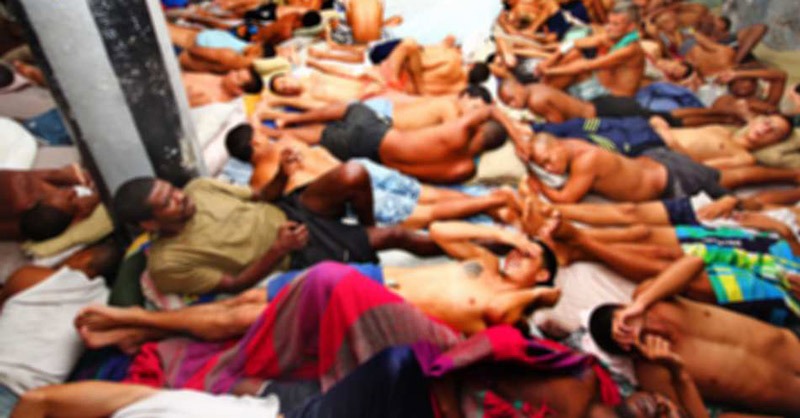Education in Prisons from an Intersectional Perspective
- Valerie Summers
- Oct 13, 2023
- 7 min read
International Day of Education in Prisons according to the European Union
This article arises from a deep exploration, combining my interest in education and my commitment to human rights. As a thesis student in Popular Education and an advocate for social and racial justice, I have focused my attention on the Villahermosa Prison in Cali. This year, I had the opportunity to enroll in a Literacy course offered by the University of Valle. This experience not only enriched my educational path but also intertwined with the transformative actions we lead in AFRORESISTANCE, focusing on the experiences of Afro-descendant families and individuals affected by the experience of incarceration.
The reality of prisons today contrasts sharply with what international human rights establish, which motivates us to review and improve our educational and human rights defense strategies. Through a perspective that considers both gender and race, this article delves into the complex relationship between intersectionality and human rights. It highlights the need to modify our practices and reflections to build a more inclusive and just environment, and how the Literacy course and my participation in the educational process within the prison added value to the context and reality analyses we carry out in AFRORESISTANCE.
🌐 Part 1: Challenges and Opportunities in Adhering to International Standards in Villahermosa Prison 🌐
Villahermosa Prison in Cali, Colombia, was built in 1955 as a response to the 'need' for a larger penitentiary establishment in the region. Over the years, the prison has housed thousands of prisoners, and since its creation, its mission has been to 'provide a safe and regulated place for incarceration while promoting the rehabilitation and social reintegration of inmates.' However, despite its original purpose, the prison has been the subject of controversy and debate due to the difficult living conditions and overcrowding problems.
In 1983, the institution had 1,000 inmates, divided into minors and adults. This combination of populations was a particular feature of Villahermosa Prison at that time. However, this mix of populations lasted until 1991 when a penal reform, aligned with the 1991 constitution, stipulated the need to separate minors from adults. As a result, the minors have been moved to a separate space up to this day.
Living Conditions and Medical Care 🚑
"Each inmate shall have an individual habitable space under satisfactory hygienic conditions" (Nelson Mandela Rules, Rule 13).
The alarming overcrowding rate of 300% in the prison highlights an inhumane living situation for individuals deprived of liberty. "The overcrowding factor in Villahermosa has a total population of 5,547 inmates compared to its actual capacity of 1,667 inmates, which generates subhuman conditions of habitability and cleanliness that affect the health and integrity of individuals deprived of liberty," stated the Public Ministry in a press release.
"Female prisoners shall be treated with regard to their gender-specific needs" (Bangkok Rules, Rule 6).

On the other hand, conditions worsen for transgender women, who face unfavorable treatment that ignores their gender-specific needs. In Villahermosa Prison, transgender women face even more restrictive conditions, being confined to their cells unless there are events or visits specifically targeted towards the LGBT community. This additional confinement not only conflicts with the orientation of the Bangkok Rules but also contradicts the Nelson Mandela Rules by limiting their access to appropriate healthcare services.
"Inmates shall have access to the available health services in the country without discrimination based on their legal status" (Nelson Mandela Rules, Rule 27).
Colombia, as a member of the United Nations, usually adheres to international guidelines on human rights and criminal justice. However, it is crucial to highlight that both the "Bangkok Rules" (United Nations Rules for the Treatment of Women Prisoners and Non-custodial Measures for Women Offenders) and the "Nelson Mandela Rules" (United Nations Standard Minimum Rules for the Treatment of Prisoners) are presented as guides, not as binding treaties in the realm of international law. This implies that, although a country expresses support for these rules, it is not legally obligated to implement them unless they are adopted within its national legislation.
Education in the Penitentiary System and the Cycle of Delinquency 📚🔄
The lack of educational opportunities is particularly alarming. According to the Nelson Mandela Rules, specifically Rule 104, the importance of education as a means of social reintegration for persons deprived of their liberty is emphasized. Additionally, the United Nations Guidelines for the Prevention of Juvenile Delinquency (Riyadh Guidelines) underline the need for education as a way to prevent recidivism. In Villahermosa Prison, educational opportunities are scarce, which not only violates these international agreements but also undermines rehabilitation and social reintegration efforts.
The non-compliance with these standards not only affects the dignity and human rights of persons deprived of their liberty but also contributes to the cycle of violence and delinquency. Prisoners who do not receive adequate education are at a disadvantage when reintegrating into society, increasing the likelihood of recidivism, contrary to the goals of the Riyadh Guidelines.
In Colombia's particular situation, issues related to human rights and the penitentiary system are of notable relevance, given the intricate social reality and the multiple challenges in terms of justice and equity that the country faces. Despite this, Colombia has ratified other international treaties concerning human rights and criminal justice, such as the Convention against Torture and Other Cruel, Inhuman or Degrading Treatment or Punishment. These treaties can be seen as broader commitments by the country towards respecting the guidelines set forth in the Bangkok Rules and Nelson Mandela Rules.
In relation to the above, it is essential that measures be taken to align practices in Villahermosa Prison with these international standards ratified by the Colombian State. This implies a joint effort to improve living conditions and offer meaningful educational opportunities in line with a humanitarian and human-rights-based approach. The transformation of the penitentiary system is not only possible but necessary, and complying with these international standards is a crucial step in that direction. ✊🏾 🔥
💡 Part 2: Popular Education and its Role in Social Transformation 💡
The Power of Popular Education 🎓
For AFRORESISTANCE, popular education is not an isolated theory; it is a praxis steeped in resistance and transformation. In a context where persons deprived of their liberty face physical and psychological violence, from solitary confinement to verbal and physical abuses by prison staff, popular education emerges as a crucial antidote. This pedagogy not only empowers but also humanizes, offering individuals deprived of their liberty tools to challenge power structures and, ultimately, to change their own lives.
Systemic Inequality: An Obstacle to Education in Prisons ⛔
The prison is not an empty space; it reflects and amplifies the inequalities and violence of the wider society. During my visits, I witnessed how these inequalities manifested in acts of violence and discrimination. From the lack of safe spaces for reading to the systematic denial of medical attention, especially for transgender women, these conditions make the learning process almost impossible. Therefore, the fight for equitable and inclusive education must also be a fight against these forms of institutionalized violence.
🤝🏾 Part 3: Intersectional Perspective 🤝🏾
My academic work and my work at AFRORESISTANCE have focused on how the intersections of gender, race, and class affect educational experiences in diverse contexts. This is in line with the goals of AfroResistance, which seeks to dismantle systems of oppression and discrimination through education and empowerment. By applying this intersectional perspective to Villahermosa Prison, I was able to observe how these forms of discrimination are magnified and intertwined.
One striking case is that of a Black man, who was the only black male instructor in the course offered at Villahermosa Prison, despite there being Black female instructors. This individual faced various forms of discrimination both from the inmates and the prison system itself. In a "pedagogical" exercise, he was chosen by a guard among all the instructors to be placed in a cage with two white inmates. The violence was not limited to verbal aggression or discrimination, but it escalated to a physical level when this black man was physically assaulted, and lifted off the ground by white men.
Subsequently, in an act of solidarity, he decided to defend me in order to prevent me, as a black transgender woman, from experiencing violence due to my gender expression, hair, and appearance. This still happened, as we were made to walk in a line with blindfolds, and I was the only woman who had her hair forcefully pulled with great violence. This scenario also reveals an additional dimension when analyzing the impact that this situation may have had on the present female instructors, who through this incident, may have reflected upon and gained a deeper understanding of the intersections of discrimination and violence that affect black and transgender individuals in these environments.
This incident not only exemplifies internalized structural racism but also illustrates how it manifests violently in certain spaces, such as a prison. We are not only talking about physical violence but also symbolic violence that reinforces their condition of subordination and exclusion, leading to a psychological and emotional incapacity to continue participating in the program. Specifically, he decided not to return. These observations resonate with the principles of AFRORESISTANCE, which seeks to confront and dismantle these structures of power through education and the promotion of equity and freedom. The analysis of these incidents within prison spaces is crucial to understand and address the multiple layers of discrimination and violence that intersect with racism, gender identity, and social position.
The Need for Critical and Inclusive Pedagogy 📖
In an environment where multiple forms of violence are an everyday occurrence, critical pedagogy is not an option; it is a moral obligation. This pedagogical approach becomes an act of resistance against a system that aspires to imprison not only the body but also the spirit and mind. It is in this precise context that my work with AFRORESISTANCE takes on a palpable urgency. Our goal is to transform these spaces of violence and oppression into arenas of learning, resistance, and ultimately, liberation. There are various ways in which you can contribute to this cause: reading and sharing this article is a crucial step in raising awareness about the situation. Sharing information and staying informed are also meaningful actions that you can undertake.
We are presented with an opportunity to implement critical and inclusive pedagogical approaches that consider these intersections of identity. Such approaches would not only be in line with international human rights norms but also represent a way to materialize the principles of AFRORESISTANCE in extremely challenging contexts. We invite you to support the work we do, especially the work with previously incarcerated women who are now collectively building to improve conditions inside and outside prisons, promoting education, human rights, and justice.
We invite you to
● Join as volunteers for the organization (info@afroresistance.org)
● Write to us and maintain open communication, especially if you want more information.
● You can also contribute to the processes of AFRORESISTANCE through donations.
Every action counts, and together we can expand the impact of our work towards a more equitable social and racial justice. For more information, we are available to share details on how to connect with us and how you can offer contributions and collaborations with AFRORESISTANCE.
#EducationInPrisons #Intersectionality #HumanRights #AfroResistance #SocialTransformation #PopularEducation #GenderJustice #RacialEquity
References 📚
1. United Nations Standard Minimum Rules for the Treatment of Prisoners (Nelson Mandela Rules) Source: United Nations - Nelson Mandela Rules
2. United Nations Rules for the Treatment of Women Prisoners and Non-custodial Measures for Women Offenders (Bangkok Rules) Source: United Nations - Bangkok Rules
3. United Nations Guidelines for the Prevention of Juvenile Delinquency (Riyadh Guidelines) Source: United Nations - Riyadh Guidelines
4. Freire, Paulo. "Pedagogy of the Oppressed." Siglo XXI Editores, 1970.
5. Foucault, Michel. "Discipline and Punish: The Birth of the Prison." Siglo XXI Editores, 1975.







